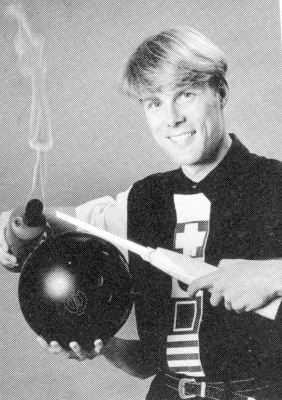 |
 |
Page 22 Fall 1990
|
He
never did what he
really wanted to do, because
he was trying to switch jobs. So as a kid,
Since
then, Nizer has definitely lived for the moment, with juggling as the
key to the experience. He
Nizer
grew up in Massachusetts, and his first inspirations came from
performers in that area. He would go to the MIT juggling club and
watch various jugglers, including Dario Pittore, one of the first
jugglers who inspired him. He also admired the Fantasy Jugglers and
Slap Happy, who performed in Boston.
The
real inspiration, however, came after he went to Boulder, Colorado,
one summer to street perform with a partner, Alan Streeter. The time
he spent in Boulder was invaluable and the people he met - including
Airjazz - influenced him greatly. "It hit me at just the right
time in my life. It brought the performing of the East Coast together
with the technique of the West Coast."
Perhaps
Nizer's most important connection made that summer was meeting Barrett
Felker. Working out and learning from Felker "opened a whole
floodgate of potential." Nizer is quick to point out that
jugglers need inspiration from other jugglers whose abilities are
within the realm of possibility - someone like Sergei Ignatov does not
work as an inspiration for most jugglers because what he does is too
far out of reach. But someone like Dick Franco, who was an inspiration
to Barrett Felker, is within more people's reach. "Dick Franco
inspired a lot of jugglers because he was the connection between
Ignatov and three balls. He was the semi-reachable goal," Nizer
said.
After
that summer in Boulder, Nizer's next big step came when he transferred
to San Diego State University and began street performing
in Balboa Park. He worked the streets of San Diego for five years,
during which he learned a lot about performing. When he started, he
was "a scared little kid who just screamed every line." But
he did improve. "You cannot beat that for training... It made me
find my character, slow down, and start writing a lot of comedy."
He
did not do it all on his own, and had help from seasoned street
performers like Ben Decker. "Ben helped me learn to write. He
took me to San Francisco, and showed me all the street performers...
And he taught me to be original, which I think is the most important
thing in any show."
Also during this time, Nizer learned a great deal from Edward Jackman, another juggler with whom he worked, performing together for two years in Balboa Park, as "Two Guys Who Juggle." They dressed in blue gas station attendants outfits, and frequently performed two new shows a day. "We would do one show, then decide it stunk and come up with a new one."
Since those days, Nizer's career has carried him to many different places. He has worked in Atlantic City, performed at Lincoln Center, opened for stars such as Ray Charles and Bob Hope, done comedy clubs and cruise ships, and many college shows. Recently, he has also begun to hit it big in the television market, an accomplishment which he feels is partly the result of getting a manager. "It really helps to have someone speak for you, whether you need it or not," he said. ",The fact that someone else believes in you enough to speak for you, I think makes a big difference in television." Appearances on Arsenio Hall, Comic Strip Live, Good Morning America, and Everyday with Joan Lunden are some of his recent television gigs.
|
 |
 |